LATEST VERSION: 29 April 2020
NEW BRUNSWICK
Stearmans organized by tail/project number/company – 1957, with notes on distribution for 1952 to 1958
Numbers 1 to 19 – Farmers’ A.S., Baxter, Pillar, Bemis
Numbers 20 to 59 – Ueding, Arizona, Quaadman, West Coast, Aero Ag, Russell, Tri-Valley, Aerial Crop
Numbers 60 to 87 – Canadian Operators – Hicks & Lawrence, Wheeler, Airspray, Bradley, Leavans Bros., Skyway
Numbers 88 to 100 – Medford and Simsbury
Numbers 101 to 126 – Farm-Air Company
Numbers 201 to 300 – Marsh Aviation
Numbers 301 to 378 – Farmers’ Crop Dusters
CF-HGV Beaver
Air Show at Charlo
CBC Newsmagazine Film
Dunphy Airstrip
Search and Rescue Helicopter
By the Skin of My Teeth: A Cropduster’s Story
Rosehill Airstrip
Accidents
Mosquito spraying, May 30
The First Fatality, June 20
More accidents in June
Accidents on July 1
Spray Planes are Forced Down – July 5
QUEBEC
Accidents in Quebec
Cap Chat Airstrip
NEW BRUNSWICK
Airstrips (14): Boston Brook, Budworm City, Charlo (Budworm Headquarters), Dunphy, Juniper, Tabu, Taxes, Grog Brook, Horne’s Gulch, MacFarlane, Nictau, Renous, Rose Hill, Sevogle. Grog and MacFarlane were constructed in 1956 for the 1957 season. No new airstrips were built in 1957.
Aircraft
22 Cessna 170s, 172s and 180s from Laurentide Aviation of Montreal.
190 Stearman, based on a 4-page list with parts unreadable or missing (see below).
This was the biggest operation of all 15 years, thirty times larger than the first in 1952, and included 24 contractors from the US and Canada. A total of 5,195,000 acres were sprayed in New Brunswick, about 30% of the province. This largest spray so far was necessary because of the widespread deterioration in the vitality of host stands following the unusually severe 1956 season (Webb, MacDonald and Cameron, 1958, Bi-monthly Progress Report 14 (3)). Twenty-two airfields in New Brunswick and Quebec accommodated about 200 Stearman sprayers and twenty-five Cessna observation planes. The FPL mixing plant was moved to Dalhousie on the Chaleur Bay to take advantage of its winter port facilities.
The Charlo airstrip was established as the operational headquarters. A full-time dispatcher, “Rusty” Mulcahy, was assigned to keep up-to-date records on the disposition of each spray plane.

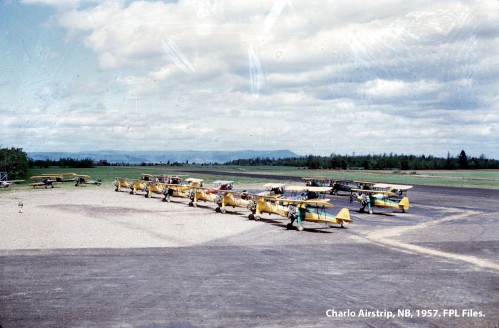

Wheeler Airlines again was charged with obtaining the aircraft, and provided all the mechanics, spare parts and equipment. The subcontractors provided the aircraft and pilots. All aircraft gathered in Fredericton where they were inspected by federal Department of Transport officials before being cleared to travel to their assigned work sites. American pilots were given letters of authority to fly in Canada. Most of the 700 personnel were employees of Forest Protection Limited, and included loaders, first aid and fire protection staff, clerks, radio operators and air traffic controllers but excluded pilots and mechanics.
By contract, all aircraft were to arrive on the project site properly calibrated, and this is the responsibility of the contractor. At the airstrip assigned, each aircraft was to be inspected by the inspection pilot after the first load flown and from time to time.
The timing of the operations from the 14 airstrips was based on a map of phenological (plant and animal cycles as influenced by weather and season) development for northern and central New Brunswick, divided into six categories. There was a difference of two weeks between the southern area (category 1 in the map below) and category 6 in the central highlands. Starting dates in the later categories could be estimated by assuming a seasonal difference of two to three days per category. Dunphy airstrip, located on the southern edge of the New Brunswick spray area, was the first to go into action, on June 4, followed by a gradual move northwards as the biologists gave the go-ahead. The entire operation came to an end in New Brunswick on July 4, when twenty aircraft operating out of Renous sprayed their last acre.

Source: Webb, F.E. 1958. Developments in forest spraying against spruce budworm in New Brunswick. Pulp and Paper Magazine of Canada. p.1-5.


The first twenty aircraft arrived in Fredericton May 23 from Old Town, Maine, to refuel. The remainder of the fleet arrived in successive waves until June 4 when all were expected to be in position at their assigned airstrips. At one point, eight Stearmans were photographed flying in V-formation over downtown Fredericton. Many officials greeted them at the airport; these included Premier Hugh John Flemming, Lands and Mines Minister Norman Buchanan, President of Wheeler Airlines F.H. Wheeler, and representatives of Forest Protection Limited. The Premier was photographed trying on a pilot’s helmet presented to him by Mr. Wheeler. The red helmet sported a logo that read “Budworm ’57”, below which were the letters WA for Wheeler Airlines.

Stearmans organized by tail/project number/company – 1957, with notes on distribution for 1952 to 1958
Below is the four-page list of Stearmans and pilots for 1957, 7th revision. It is much annotated, some of it is unreadable or barely readable (especially page 1, numbers 1-46). The lower left quarter of page 4 is missing, undoubtedly from being folded and carried in a back pocket. The information is invaluable, containing the aircraft registration, assigned airstrip (added in pen), engine hours since overhaul, pilots (those with previous spraying experience denoted by an asterisk * – total >48; a ? means that I am not sure of the spelling), pilot’s license number and operator. I’m glad that someone kept this, as this is all we have!
In some cases, the planes were listed at a different airstrip. For example, Elwyn Behnke was listed as being stationed at Tabu but actually flew out of Budworm City the morning of his fatal accident. Stearman in bold have either an image or a Canada Department of Transport (DOT) accident card to illustrate their presence in 1957. Also, several pilots were photographed posed beside their aircraft at probably Charlo airstrip; the names of these pilots are bolded and illustrated below. These pilots are all employees of Farmer’s Crop Dusters and Vince Dusters, located on the part of the list that is missing.
Most of the images from the Forest Protection Limited files come from the Vince Duster and Farmers’ Crop Duster aircraft stationed at Charlo. There are not many images of the rest of the project, but some are provided where available.
Many of the extra Stearman aircraft brought in for the enhanced budworm spray operation operated in New Brunswick only in 1957 (red text), and a few both 1957 and 1958 (green text). Only a few U.S. aircraft flew here in the mid 1960s. These dates are noted after each plane below.


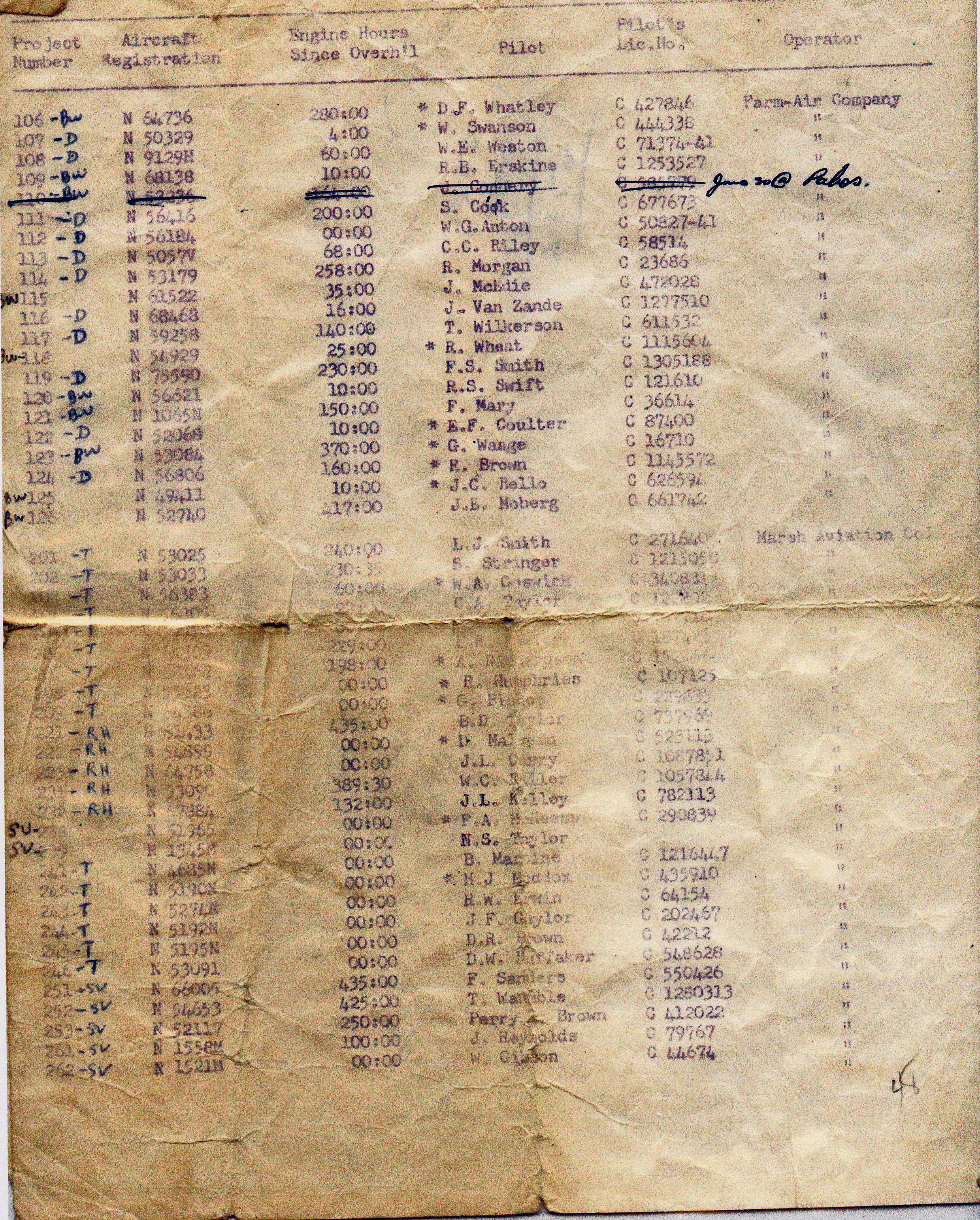

Numbers 1 to 19 – Farmers’ A.S., Baxter, Pillar, Bemis
Farmers’ Air Service, Klamath Falls, Oregon Flew out of Boston Brook (BB on list). Farmers AS (FAS) obtained #1 to #7 from the US military and #8 from Central Aircraft in 1957. No images are available from 1957.
#1 N62775 – J. Ellis – #84 in 1955-56
#2 N53399 – J. Retterath – 1957 only. Not in North American list of Stearmans.
#3 N58680 – D. Stammerjohn? – Central #15 in 1953, Farmers’ #83 in 1957-58. Not in North American list of Stearmans.
#4 N53483 – L. Anderson – 1957-58. Not in North American list of Stearmans.
#5 N56773? – R. Gardener – Farmers’ #85 in 1955,56. Not in North American list of Stearmans.
#6 N4742V? – *L.W. Olsen – 1957 only
#7 N4758V – R. Nelson – 1957 only
#8 N4769V – S. Martin – 1957 only as #8; Central #14 1952-53, purchased by FAS in 1957
Baxter Aircraft Inc, Yakima, Washington Flew out of Boston Brook (BB on list). These are several of the old Central Aviation aircraft owned by Al Baxter.
#9 N1724B – A.B. Roberts – 1957 only
#10 N1729B – *R.F. Schmidt – in N.B. 1954-56 as Baxter #20
#11 N4811V – H.F. Thierman – 1953 as Central #20
#12 N68441 – *J. Kellogg – Central #5 1952-53, #15 1954-55; Baxter #12 1956-57
#13 N1731B – A.H. Ketcham – Central #21 1953-54, 56
#14 N1307N – *R. Dobrinska – 1957 only
Pillar Air Service, Andy Pillar Flew out of Renous (RN on list)
#15 N1152N – J.A. Anthony – 1957-58 as #15, 1955-56 as #37
Bemis, Kenneth L., Brawley, Calif. (image below) Flew out of Nictau (N on list)
#16 N63402 – *L.E. Stimson – 1957 only
#17 N56456 – M.L. Campbell – 1957 only
#18 N66523 – J.J. Chisum – 1957 only
#19 N5028V – H.C. Allee – 1957 only

Numbers 20 to 59 – Ueding, Arizona, Quaadman, West Coast, Aero Ag, Russell, Tri-Valley, Aerial Crop
Ueding Flying Service, Vincennes, Indiana (Bob Ueding)
Flew from MacFarlane (Mac on list)
#20 N53545? – P.J. Arthion – 1957 only, unreadable on list
#21 N55898 – *W.M. Mains – Ueding #21 in 1957-58, #96 in 1955-56, #408 in 1966
#22 Nxxxxx? – *? Richardson – 1957 only, unreadable in list
#23 Nxx297? – *M.W. Trinkle? – 1957 only
#24 N5x397? – L. Corvissiano – 1957 only
#25 N1585V – H.M. Cook – 1957 only
#26 N9719H – J. Rothius – Hammer #53 in 1955-56
#27 N1535N – V. Bullard, accident June 25 near MacFarlane airstrip, substantial damage (see accidents) – 1957 only
Arizona Aviation, Safford, Arizona
Flew from Nictau (N on list)
#28 N56716 – L.E. Prothero – Arizona #29 in 1954-55, #25 in 1956
#29 N1310N – N.R. Parnell (name underlined in list; replaced by Ballester after his accident?) – Central #6 in 1952, #26 in 1953; Arizona #28 in 1954-57
Quaadman Dusters, Corcoran, California (Greg Quaadman)
Flew from Budworm City (BW on list).
#30 N59448 – E. Gentry – Quaadman #30 in 1955-57
#31 N1318N – D. Baker – Quaadman #31 in 1955-58
#32 N68456 – Ernesto Ballester – a #29 is placed beside his name, so presumably reassigned to that aircraft after accident June 25 at Nictau, substantial damage – Quaadman #32 in 1955-57
#33 N56843 – F. Maglio – Quaadman #33 in 1955-58
#34 N68461 – *G. Mowen – Central #34 in 1953; Quaadman #34 in 1954-58
#35 N68455 – T. Insall? – Central #35 in 1953; Quaadman #35 in 1957-58
#36 N68458 – *E. Turner – Central #36 in 1953; Quaadman #36 in 1954,57
#37 N62630 – H. Blowers – Central #37 in 1953-54; Quaadman 35 in 1955, #37 in 1956-57
West Coast Air Service, ?
Flew from Renous (RN on list)
#38 N1059N – J.S. Burft – 1957 only
#39 N5852B – D. Simpson – 1957 only
Aero Agricultural Service, ?
Flew from Tabu (Tabu on list)
#40 N5214N – A.V. Adolph – #40 in 1955-57
#41 N66301 – *B.H. Hinshaw – #41 in 1955-57
#42 N75669 – R.E. Stance – #42 in 1956-57
#43 N57935 – *W. MacBridges – 1957 only
#44 not used
Russell Dusting Company, San Antonio/Pecos, Texas
Flew from Nictau (N on list)
#45 N4747N – *D. Royal – Central #1 in 1952-53, Russell #45 in 1954-57
#46 N64358 – D.G. Dickson – Russell #46 in 1955-57
#47 N59727 – D.J. Betenbough – Central #47 in 1953-55, Russell #47 in 1956-57
#48 N5216N – C.E. West – 1957 only
#49 not used
Tri-Valley Dusters, Holtville, Calif. (owners Marion and Mary Louise Walker) Flew from Nictau (N on list)
#50 N46818 – D. Edwards – 1957 only
#51 N57449 – D.J. Chessman – 1957 only
#52 N4881N – K.N. Wells – 1957 only
#53 N67517 – M.R. Walker – flown by owner – 1957 only
#54 not used
Aerial Crop Service, Carlsbad, Calif.?
Flew from MacFarlane (Mac on list)
#55 N69881 – *R. Cox – Aerial #98 in 1955-56
#56 N50087 – H. Clevenger – Aerial #97 in 1955-56
#57-#59 not used
Numbers 60 to 87 – Canadian Operators – Hicks & Lawrence, Wheeler, Airspray, Bradley, Leavans, Skyway
Hicks & Lawrence Ltd., Ostrander, Ontario
Flew from Renous (RN on list)
#60 CF-JOU (typo, JOV in list) – George Franklin Pressey, crashed May 29 near Courcelle, Quebec, see accidents – 1957-58
Wheeler Air Lines Ltd., St. Jovite, Quebec
Flew from Rosehill (RH on list) (all flew every year in N.B. 1953 to 1958 and some into the 60s and 70s)
#61 CF-EQS – *M. Gordy – 1953-58
#62 CF-EQT – *M. Beluse – 1953-58
#63 CF-EQU – *P. Holtendorp – 1953-58
#64 CF-EQV – A. Becker – 1953-58
#65 CF-EQW – *R. Craven – 1953-58
#66 CF-EQX – A. Pooley – 1953-58
#67 CF-EQY – *Rodney Turner Wray – 1953-58. Accident May 30 near Moncton while spraying DDT on marshes, substantial damage, see accidents below. EQY was repaired and was active in the aerial spray program as late as 1969.
Airspray Ltd., Wetaskiwin, Alberta
Flew from Rosehill (RH on list)
#68 CF-IAD – T.W. Korpatniki – 1957-58
#69 not used
Bradley Air Services Ltd. Carp, Ontario
Flew from Juniper (Ju on list) (most flew every year 1954 to 1958)
#70 CH-HKZ – *L. Moffatt – Bradley #70 1954-57; Skyway #80 1957-58. Typo in list, was HXZ; accident at Cartierville, Quebec May 30 as HKZ ran into a parked JLS; see accidents.
#71 CF-FBD – *J. Fewell – 1954-58
#72 CF-DZC – E.A. Waters – 1954-58
#73 CF-DQP – A.E. Bradley – 1953-58
#74 CF-IBA – S. Dsus – 1954-58
Leavens Brothers Air Services Ltd., Essex, Ontario
Flew from Juniper (Ju on list)
#75 CF-FRY – *Doug Worgan; accident at Budworm City July 1, substantial, pilot John Lingham; see accidents – 1953-58
#76 CF-FRW – *J.D. Burgess – 1953-58
#77 CF-FRZ – *R. Hodgins – 1953-58
#78 CF-GAR – John Leslie Lingham – #22 in 1952, #78 in 1953-58
Skyway Air Services Ltd., Langley, British Columbia
Flew from Juniper (Ju on list)
#79 CF-xxx – J.C.F. Blackham – A crease across the page obscures most information.
#80 not used
#81 CF-DFC – R. Elmore – 1953-57
#82 CF-DQL – *Tom R. Marston – Tom Marston was the first Canadian fatality of the budworm spray in 1958. – 1953-58
#83 CF-FBU – *Tom M. Wilson, unreadable pen inscription beside name but could refer to T. Marsten – #20 in 1952, #83 in 1953-54, 1957
#84 CF-JLS – *O. Osen – 1957 only. Accident at Cartierville, Quebec, stopover on ferry to N.B., May 30 as HKZ ran into a parked JLS; see accidents.
#85-#87 not used


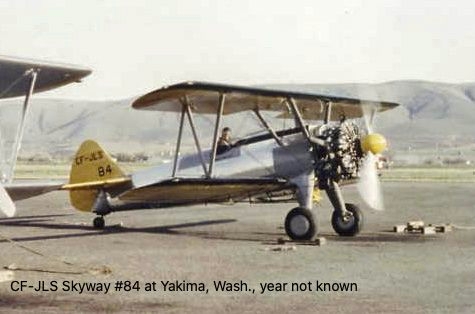

Numbers 88 to 100 – Medford and Simsbury
Medford Air Services, Medford, Oregon
Flew from Taxes (T on list)
#88 N57415 – L.T. Rickers – 1957 only as Medford #88; Airspray #69 CF-LOB 1958
#89 N70036 – J. Starkey – 1957 only
#90 N1054N – Elwyn G. Behnke – Central #10 1952-53, Medford #90 1954-57. Behnke was the first fatality of the entire 6-year program, June 20 near Budworm City; see accidents.
#91 N5158N – *D.P. Newton – 1957 only

Simsbury Flying Services, Simsbury, Connecticut
Flew from Tabu (Tabu on list)
#92 N1241V – C.E. Onfer – 1957 only
#93 N2535R – G. Cavoli – 1957 only
#94 N60723 – W. Portlock – 1957 only
#95 N58067 – R. Schuean? – 1957-58
#96 N58065 – V.Y. Leach – Medford #100 in 1953-54, Simsbury #102 in 1955-56, #96 in 1957-58
#97 N60255 – R.C. Deacomb – 1957-58
#98 N53899 – *G. Bailey – 1957 only
#99 N9386H – K. Goodall – Medford #101 in 1954, Simsbury #101 in 1955, #99 in 1956-58
#100 not used
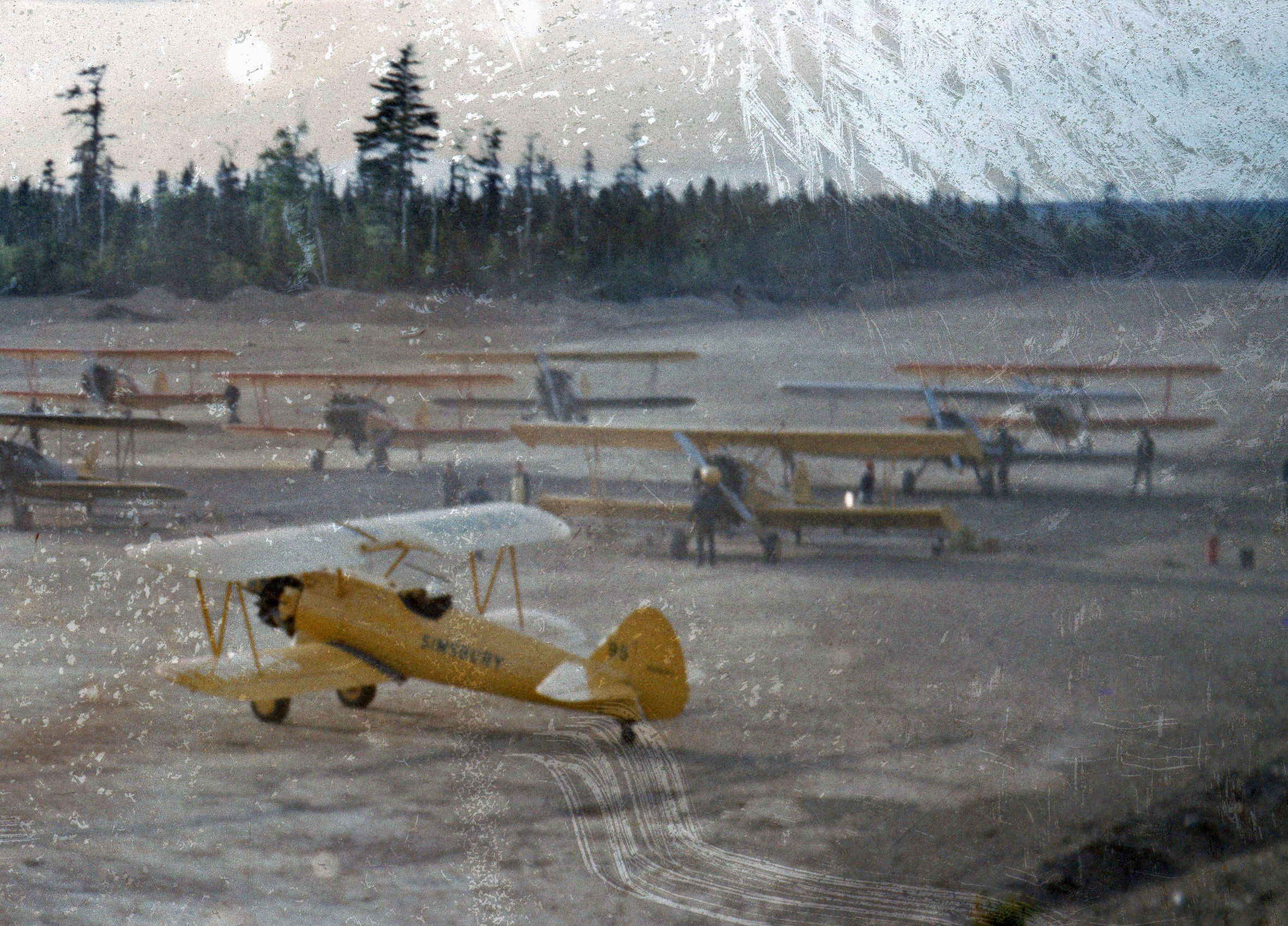

Numbers 101 to 126 – Farm-Air Company
Farm-Air Company, West Sacramento, Calif.
Distributed between Budworm City (BW on list) and Dunphy (D on list)
#101 N56237 BW – *W. McMahon – crossed out and replaced with Bailey – 1957 only
#102 N49366 BW – *Robert Annon – crossed out and replaced with Mac – 1957 only. Eventually sold to Hicks and Lawrence Ltd. of Ostrander, Ontario, in the 1960s
#103 N1323N BW – D. Bailey – 1957 only. For image see Dunphy Airstrip below.
#106 N64736 BW – *D.F. Whatley – #5 in 1955, #106 in 1956-57
#107 N50329 D – *W. Swanson – Involved in the first Stearman crash, 1952 (see 1952), and still flying – 1957 only
#108 N9129H D – W.E. Weston – Central #57 in 1953, Hammer #57 in 1954-55, Farm-Air #108 1957 only
#109 N68138 BW – R.B. Erskine – 1957 only
#110 N53236 BW – J. Connery – 1957 only. Entire entry crossed out on 1957 list, “June 30 @ Pabos”, Quebec, entered in pen; crashed at Pabos airstrip June 30, flown by Robert Annon, destroyed by fire, no injuries; DOT card states that the aircraft is operated by Miller Dusting Company, perhaps a contractor under Farm-Air.
#111 N56416 D – S. Cook – 1957 only
#112 N56184 D – W.G. Anton – 1957 only
#113 N5057V D – C.C. Riley – 1957 only
#114 N53179 D – R. Morgan – 1957 only
#115 N61522 BW – J. McLadie? – 1957 only
#116 N68468 D – J. Van Zande – 1957 only
#117 N59258 D – T. Wilkerson – Central #51 in 1953
#118 N54929 BW – *R. “Buck” Wheat (see image under Baxter) – 1957 only
#119 N75590 D – F.S. Smith – 1957 only
#120 N56621 BW – R.S. Swift – 1957 only
#121 N1065N BW – F. Mary – #121 in 1953, 1956-58, #1 in 1954-55
#122 N52068 D – *E.F. Coulter – #122 in 1953, 1957
#123 N53084 BW – *G. Waage – #123 in 1953, 1957-58, #3 in 1954-56
#124 N56806 D – *R. Brown – #124 in 1953, 1956-57, #2 in 1954-55
#125 N49411 BW – *J.C. Bello – 1957 only
#126 N52740 BW – J.E. Moberg – 1957-58
Numbers end at #126 and restart under Marsh at #201.
The following images come from the Provincial Archives of New Brunswick, located in Fredericton. They show four Farm-Air Stearmans spraying: N56416 #111, N5057V #113, N68468 #116 and N52068 #122.



Numbers 201 to 300 – Marsh Aviation
Marsh Aviation Co. Inc., Mesa, Arizona
Distributed among the following airstrips: T – Taxes, RH = Rosehill, SV = Sevogle, RN = Renous, D = Dunphy
#201 N53025 T – L.J. Smith – #88 in 1953-55, #201 in 1956-58
#202 N53033 T – S. Stringer – 1957-58
#203 N56383 T – *W.A. Goswick – #87 in 1953-55, #203 in 1956-58
#204 N56805 T – C.A. Taylor – #89 in 1953-56, #204 in 1957-58
#205 N59950 T – pilot name unreadable, on crease – 1957-58
#206 N64385 T – F.R. Sawler? – 1957-58
#207 N68162 T – *A. Richardson – #86 in 1953-55, #207 in 1956-58
#208 N75623 T – *R. Humphries – 1957-58
#209 N64386 T – *G. Bishop – 1957-58
#210-#220 not used
#221 N61433 RH – B.D. Taylor – 1957 only
#222 N54899 RH – *D. Malvern – 1957-58
#223 N64758 RH – Joseph L. Curry – 1957 only. Crashed 5 July 5 km south of New Maryland, one of the five aircraft forced down because of fog and loss of fuel: damage substantial, injuries minor.
#224-#230 not used
#231 N53090 RH – W.C. Kaller – #93 in 1955, #231 in 1956-57
#232 N67884 RH – J.L. Kelley – #88 in 1955-56, #232 in 1957
#233-#237 not used
#238 N51965 SV – *F.A. McNeese – 1957 only
#239 N1345M SV – N.S. Taylor – 1957 only
#240 not used
#241 N4685N T – B. Marwine – 1957 only
#242 N5190N T – *H.J. Maddox – 1957 only
#243 N5274N T – R.W. Erwin – 1957 only
#244 N5192N T – James F. Gaylor – 1957 only. Crashed June 9 at Taxes airstrip, substantial damage, no injuries, pilot Gaylor. The DOT card states that N5192N was operated by the American Dusting Company.
#245 N5195N T – D.R. Brown – 1957 only
#246 N53091 T – D.W. Huffaker – 1957 only
#247-#250 not used
#251 N66005 SV – F. Sanders – 1957 only
#252 N54653 SV – T. Watable? (on crease) – 1957-58 #252 in 1957, #212 in 1958
#253 N52117 SV – Perry Brown – 1957 only
#254-#260 not used
#261 N1558M SV – J. Reynolds – 1957 only
#262 N1521M SV – W. Gibson – 1957 only
#263 N48769 RN – R. Kern – 1957-58 #263 in 1957; to Mid Continent Aerial Sprayers Inc., Hayti, Missouri, #435 in 1958
#264 N1715M RN – A. Strong – 1957 only
#265 N73444 SV – E.W. Osborne – 1957 only
#266 N75517 SV – G.S. Butler – 1957 only
#267 N58477 RN – Bill Tedder – 1957 only
#268 N75360 SV – F.W. Bailes, jr. – 1957-58 #268 in 1957, #211 in 1958
#269 N75361 SV – Jack Lowers – 1957 only
#270 not used
#271 N53429 RH – *W. Robinet – 1956-57
#272 N66283 T – *C.O. Diefendorf – 1957 only
#273-#277 not used
#278 N4762N – A. Berkes – 1957 only, location not indicated
#279 N4812V RH – M. Ezell – 1957 only. One of 5 planes forced down near Fredericton on July 5 ferry, piloted by Bill Lininger
#280 not used
#281 N1148N RN – Ernest Marquis – 1957 only
#282 N56907 RN – Leroy Moore – 1957 only
#283 N4786V RN – Oscar Knight – 1957 only
#284 N4740N RH – Richard H. Joyce – 1956-57, #47 in 1955. One of 5 planes forced down near Fredericton on July 5 ferry, piloted by R. Joyce
#285 blank
#286 N1142N SV – D. Sorenson – 1957 only
#287 N1145N SV – C. Bowlsby – 1957 only
#288 N58978 SV – T. Atkinson – 1957 only
#289 N58715 SV – B. Buchanan – 1957 only
#290 not used
#291 N4789V RH – M. Curtis – 1957 only
#292 N49377 RH – R.L. Sheppard – #28 in 1953
#293 N4774V SV – J.C. Miller – 1957 only
Earlmart Dusters, ?
#294 N63543 SV – W.S. Wood – 1957 only. Probably subcontracted to Marsh but operator name can be seen on the tail.
#295-#300 not used
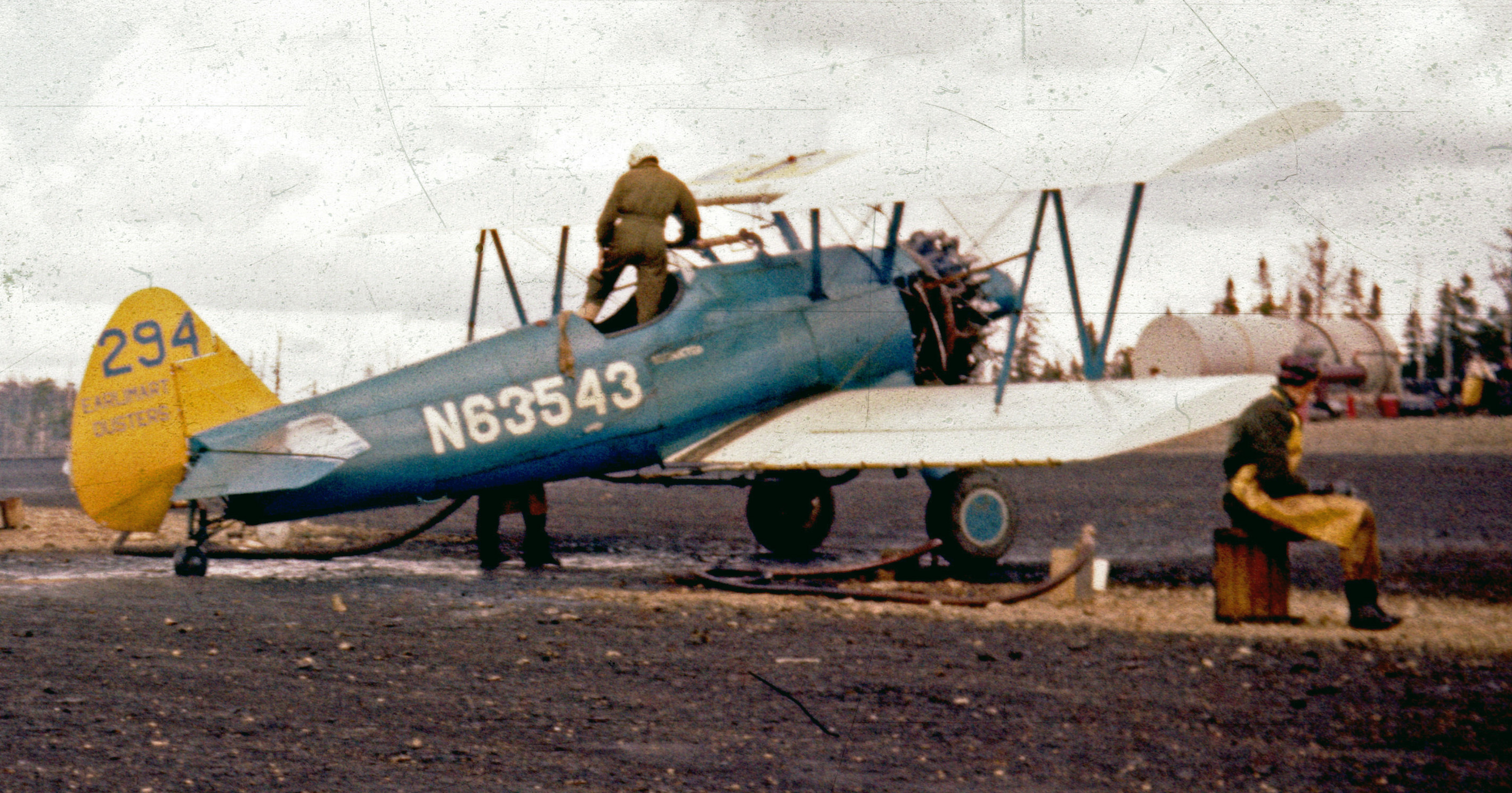
The following two images show two rows of gaily painted Marsh Stearmans probably at the fly-in at Fredericton Municipal Airport in May 1957. The left image shows the right-hand row, which shows #245 N5195N, #243 N5274N and #242 N5190N. One image shows both rows, in which can be seen the three above and also #244 N51924. An image of #243 flying is included under the CBC Newsmagazine film section below.


Numbers 301 to 378 – Farmers’ Crop Dusters
Farmers’ Crop Dusters, Bakersfield, Calif. / Vince Dusters, Buttonwillow, Calif.
Location probably Charlo Airstrip. Strangely, this is where we have the most images of the entire spray fleet. Here the lower left quarter of the folded sheet is missing. Ditto marks under Marsh Aviation continue for 24 more entries, but #301 is on a crease that obscures the company name. Some of the registrations are gleaned from the colour images from the FPL files. Some are Vince Dusters (most of them have sawed off wing tips and brown or dark blue bodies) and some are Farmers’ Crop Dusters (yellow with large red lettering on sides). All are subcontracted to Marsh Aviation, as that is the operator name at the top of the page.
#301 N5015V (brown body) Vince Dusters – Homer F. Kliewer – 1957 only. To Budd Aero Inc, Dinuba, CA 6 Aug 1956 with new c/r N5015V (PT-13D, 75-5609) [Aerial Visuals]
#302 N5013V (brown body) Vince Dusters – Tom Douglass, Fresno, Calif. – 1957 only
#304 to #309 probably not used
#310 N53154 Farmers’ Crop Dusters – Robert Eakin, Van, Pennsylvania – 1957 only
#311 N48792 Farmers’ Crop Dusters – 1957 only
#312 N66961 Farmers’ Crop Dusters – 1957 only
#313 Nxxxxx Farmers’ Crop Dusters – see note below
#314 N63585 Farmers’ Crop Dusters – 1957 only
#315 N67203 Farmers’ Crop Dusters – 1957 only
#316 N53040 Farmers’ Crop Dusters – J. Welton, called Foster Welton on image – 1957 only. Crashed 1 July 4 mi northeast of Nepisiguit Lake, damage substantial, no injuries
#317 N56910 Vince Dusters – 1957 only
#318 no info – see note below
#319 N56439 (dark body) Vince Dusters – 1957 only
#320 no info – see note below
#378 N66658 (dark body) Vince Dusters – 1957 only
NOTE: Re identities of #313, #318 and #320. We have identified two N-numbers from images, but without the tail number being visible. These are: N56443, which could be #318 or #320; and N68253, which could be #313 or another. Both are dark-bodied Vince Dusters Stearmans.
What are the missing numbers? The list of numbered registrations ends at #301 N5015V with pilot Kleiwer, because of the missing quarter page, so the rest are identified from images (see above): #310, #302, #310 to #320, and the odd number out, #378. We have only the pilots’ license numbers without their names. There are no images of #303 to #309, so maybe these numbers were not used. That leaves 14 identified aircraft, including the three mentioned above. However, 25 pilots in this Charlo group are listed by their license numbers (except for one that is blank), but the part that reveals the associated Stearman is missing. I have not tried to make up numbers here, and it is not possible to identify the pilots by their license number, although three can be identified by their Stearman in the pilots series of images below and one from a DOT accident card. I have added them in above. So, do the numbers carry on from #320 or are there also numbers in the 370s?
Line-ups at Charlo airstrip, June 1957. Check the images to see the aircraft that can be identified, which include #301, #302, #310, #312, #314, #315, #319 and #378.
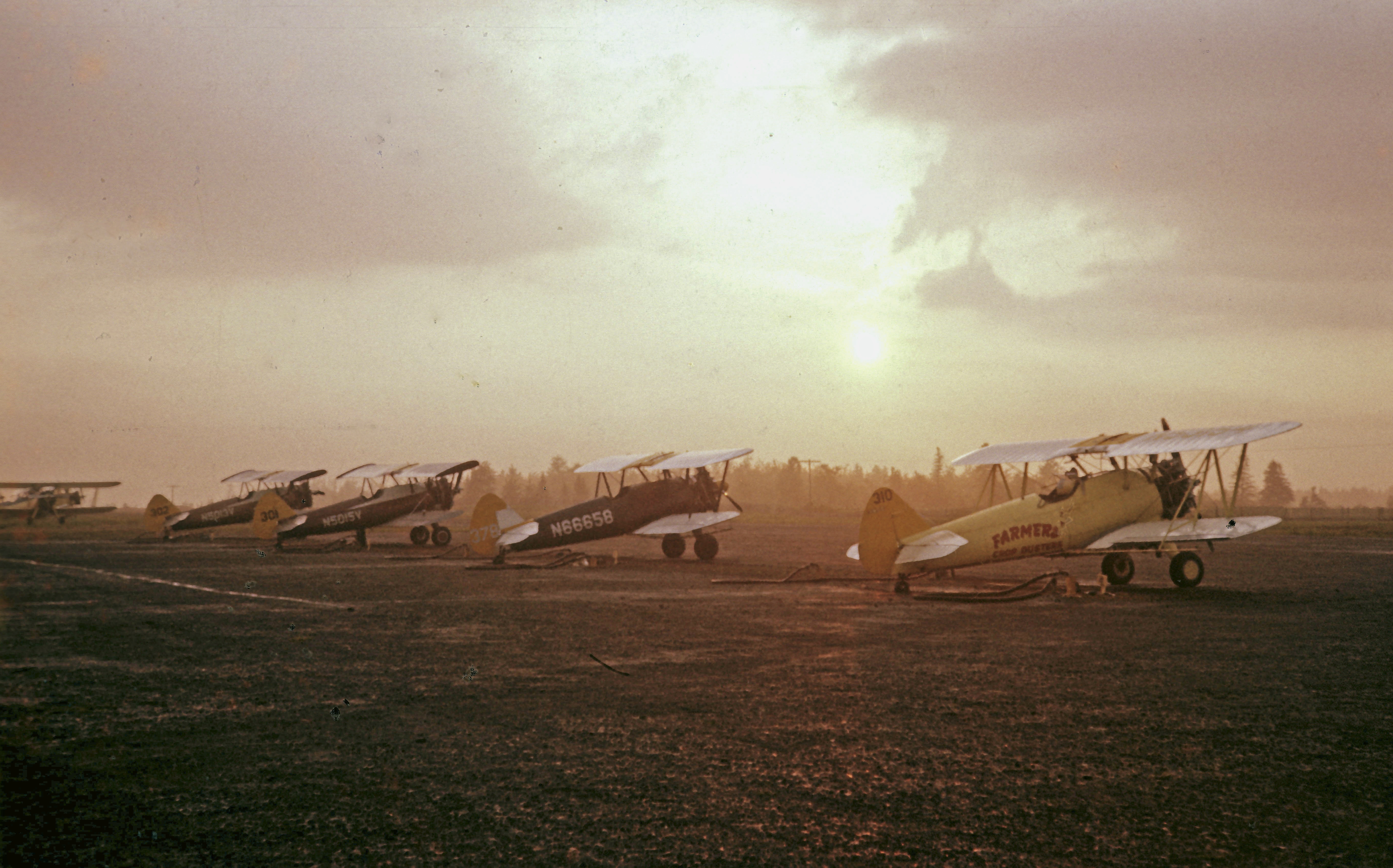
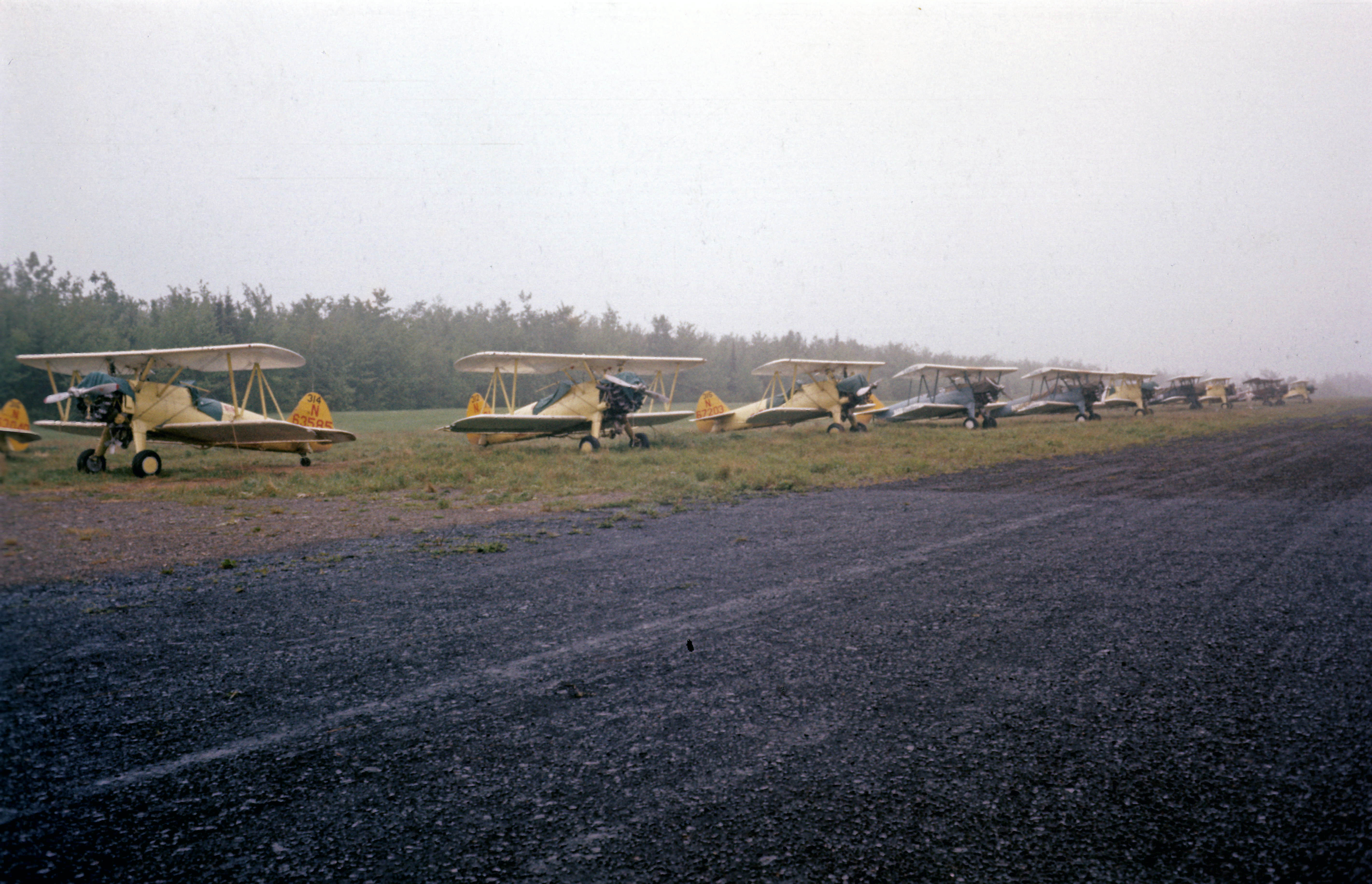
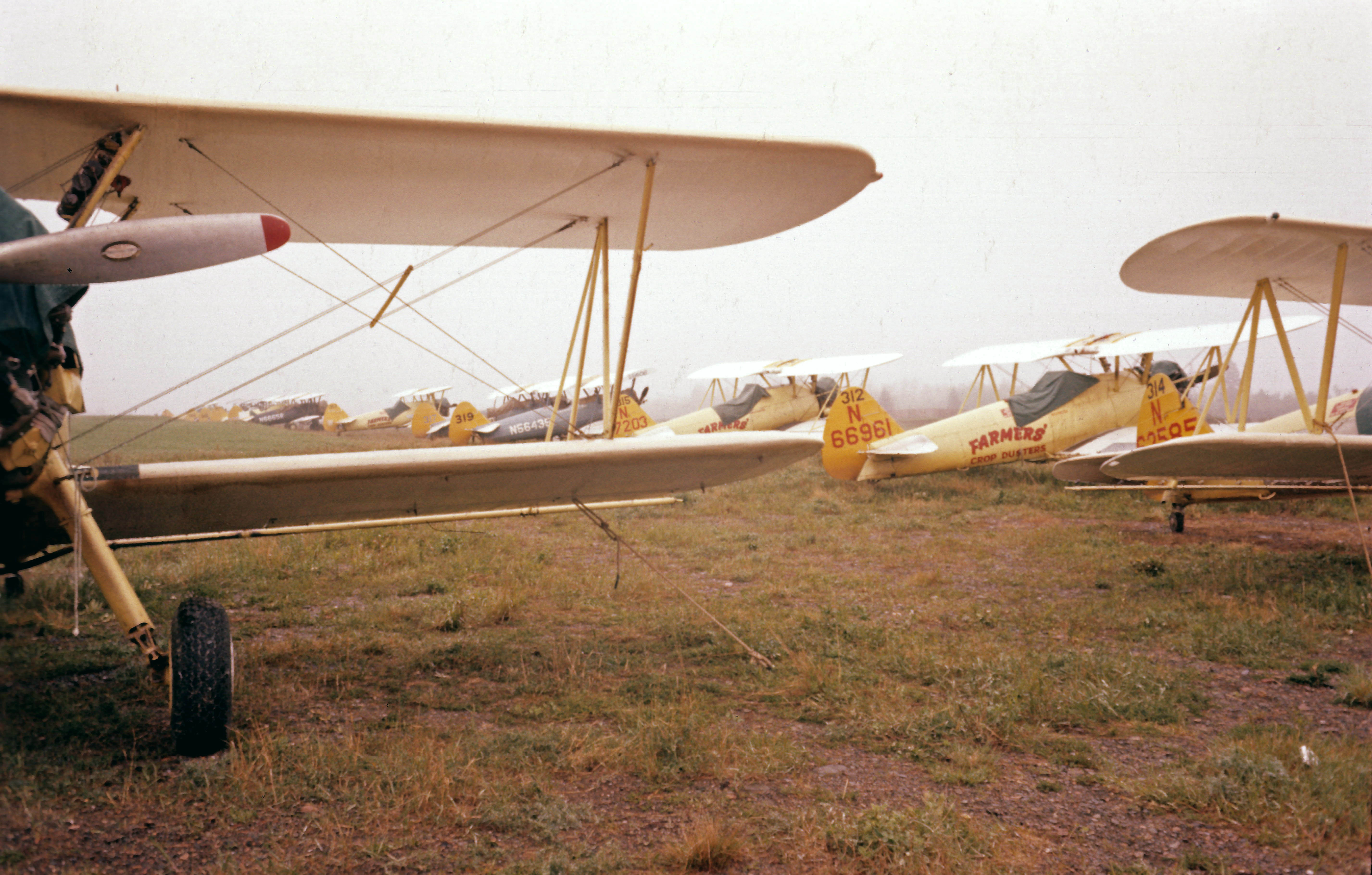
Three Flying Stearmans, #311, #317 (taking off) and two unidentified included to show the typical terrain of northern New Brunswick.



Close-ups of several aircraft, including #301, #302, #310, #312, #314, #315, #316, #319 and #378.




Three images of Vince Dusters Stearman N66658 #378. Also appearing are N53154 #310 and one of the mystery Stearmans N68253 #3xx.



Pilots and their Aircraft. Fourteen pilots, seven from each company, were photographed beside their aircraft at Charlo airstrip. The photographer is not known, and these are all from the Forest Protection Limited files. Only five of the aircraft are identified: Vince Dusters N5015V #301, N5013V #302 and one of the mystery Stearmans, N68253 N3xx. Also identified with the pilots are Farmers’ Crop Dusters N53154 #310 and N53050 #316.
Pilots: Farmers’ Crop Dusters

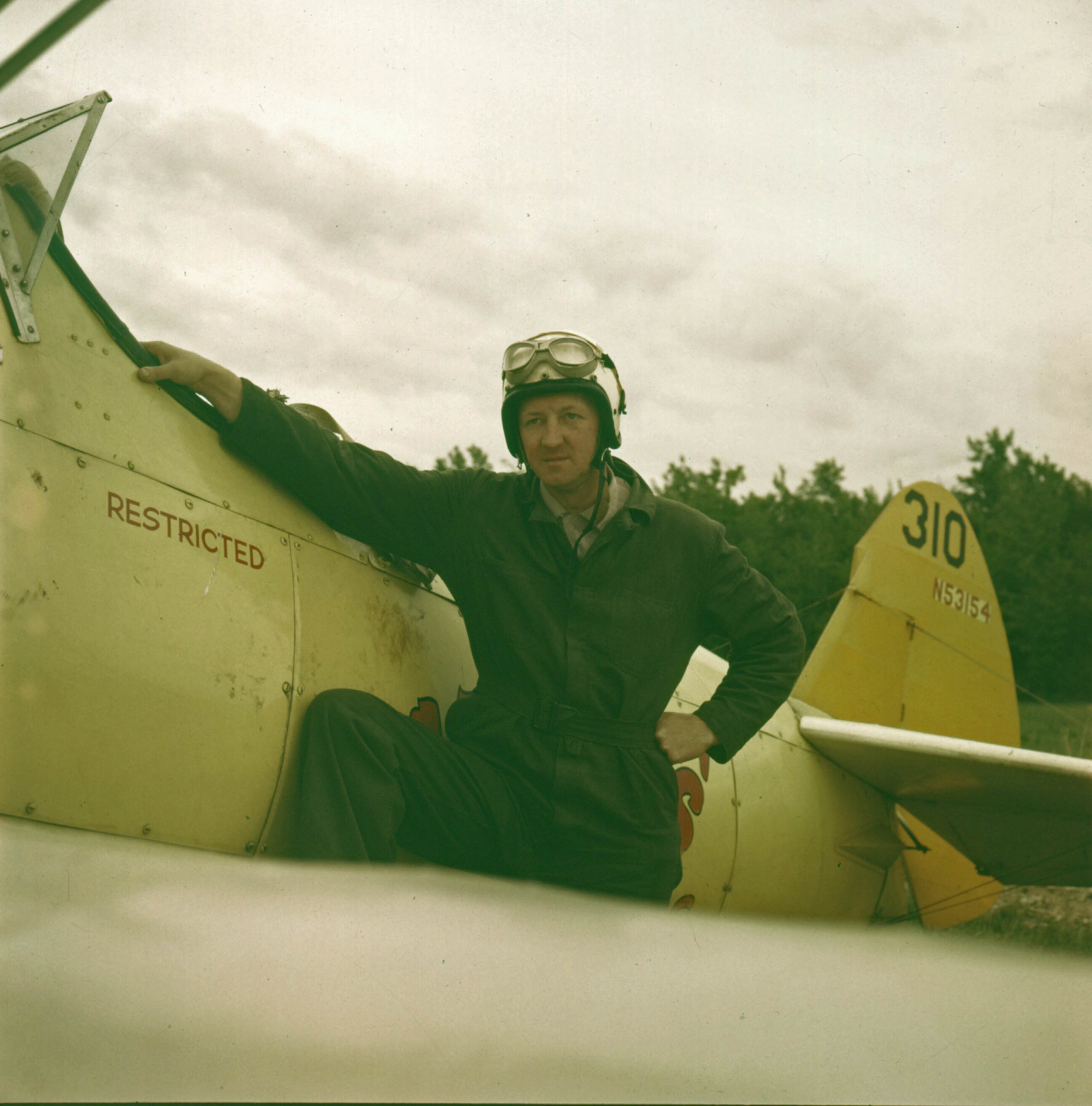




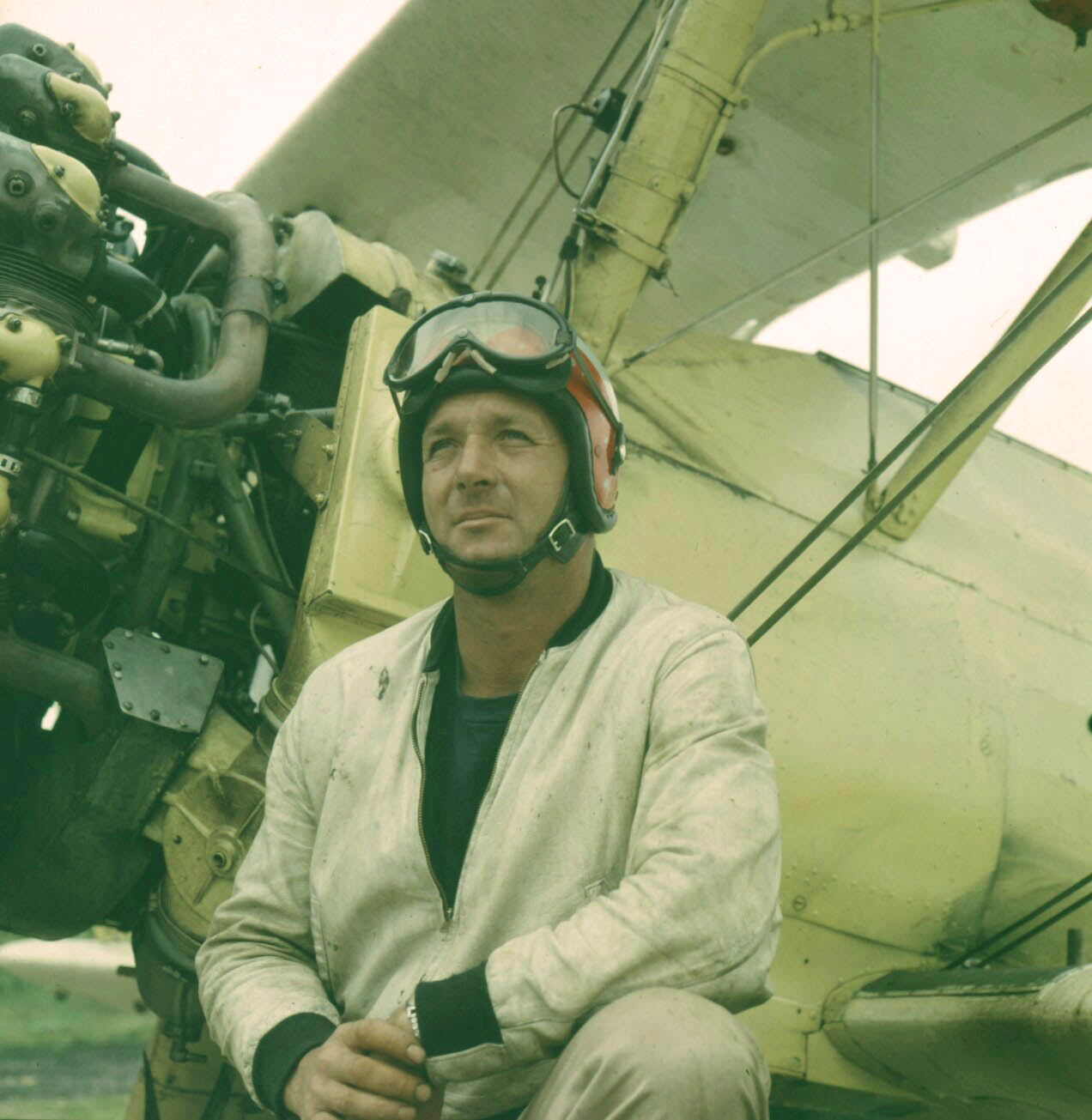
Pilots: Vince Dusters
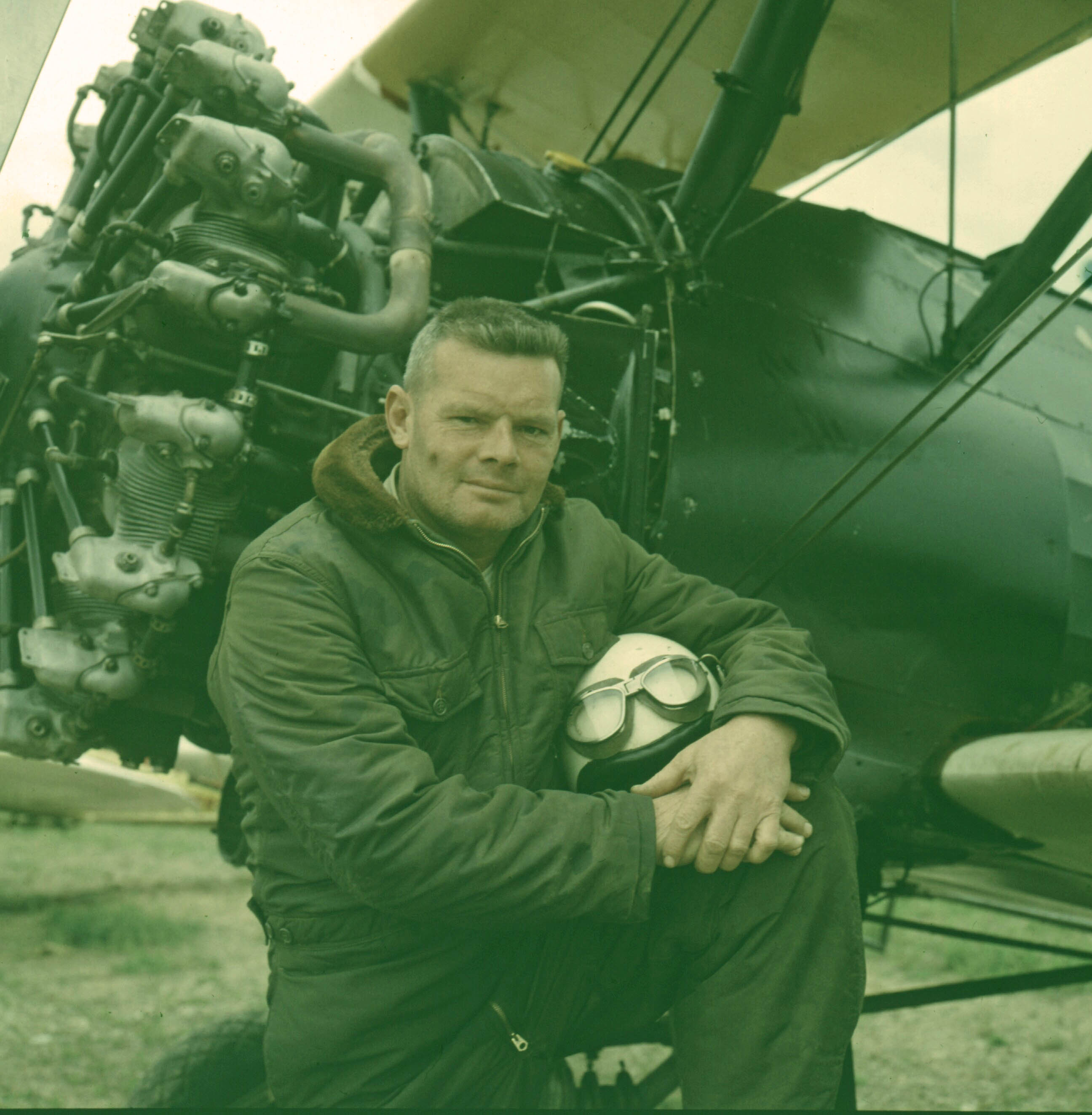
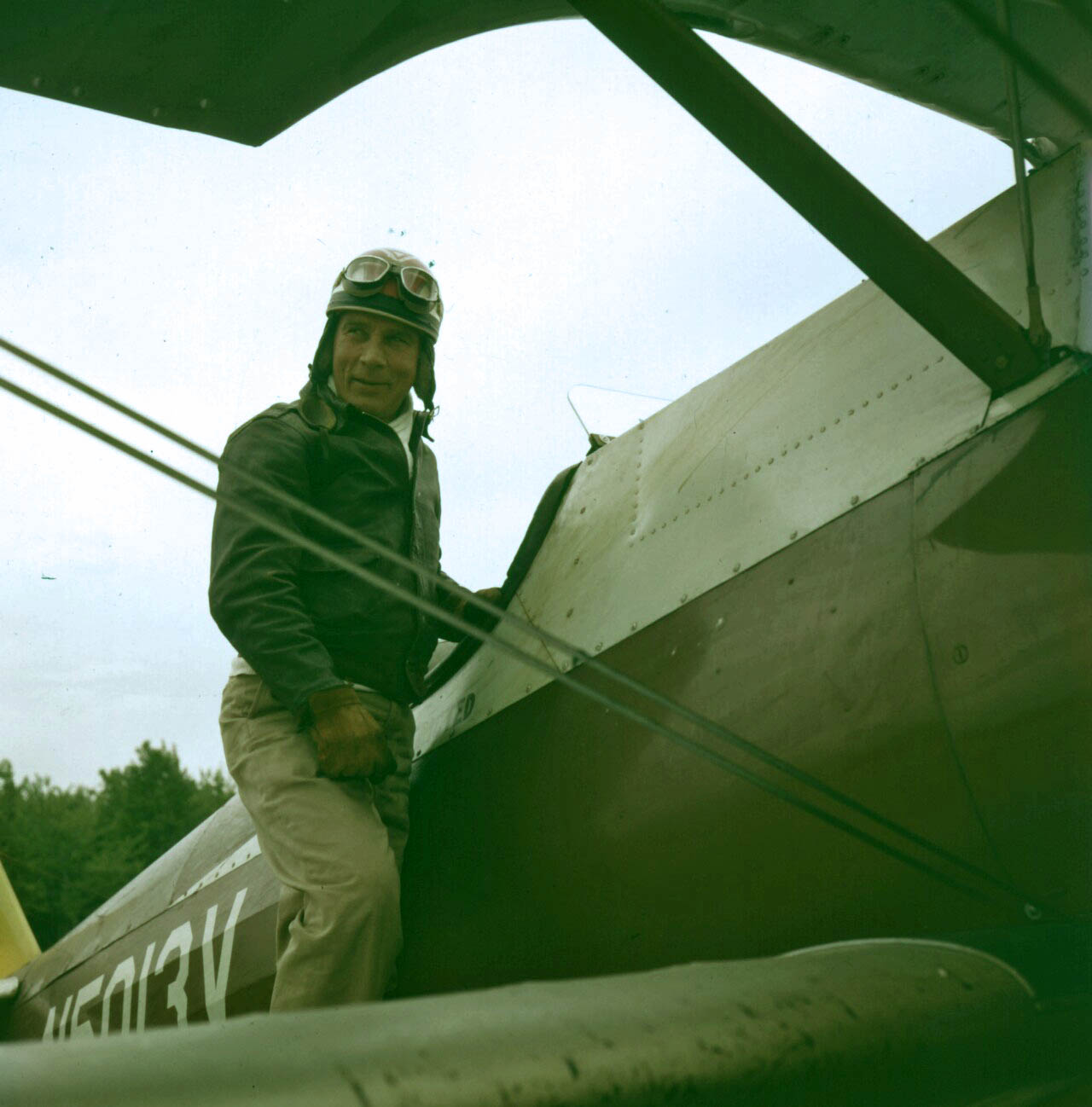

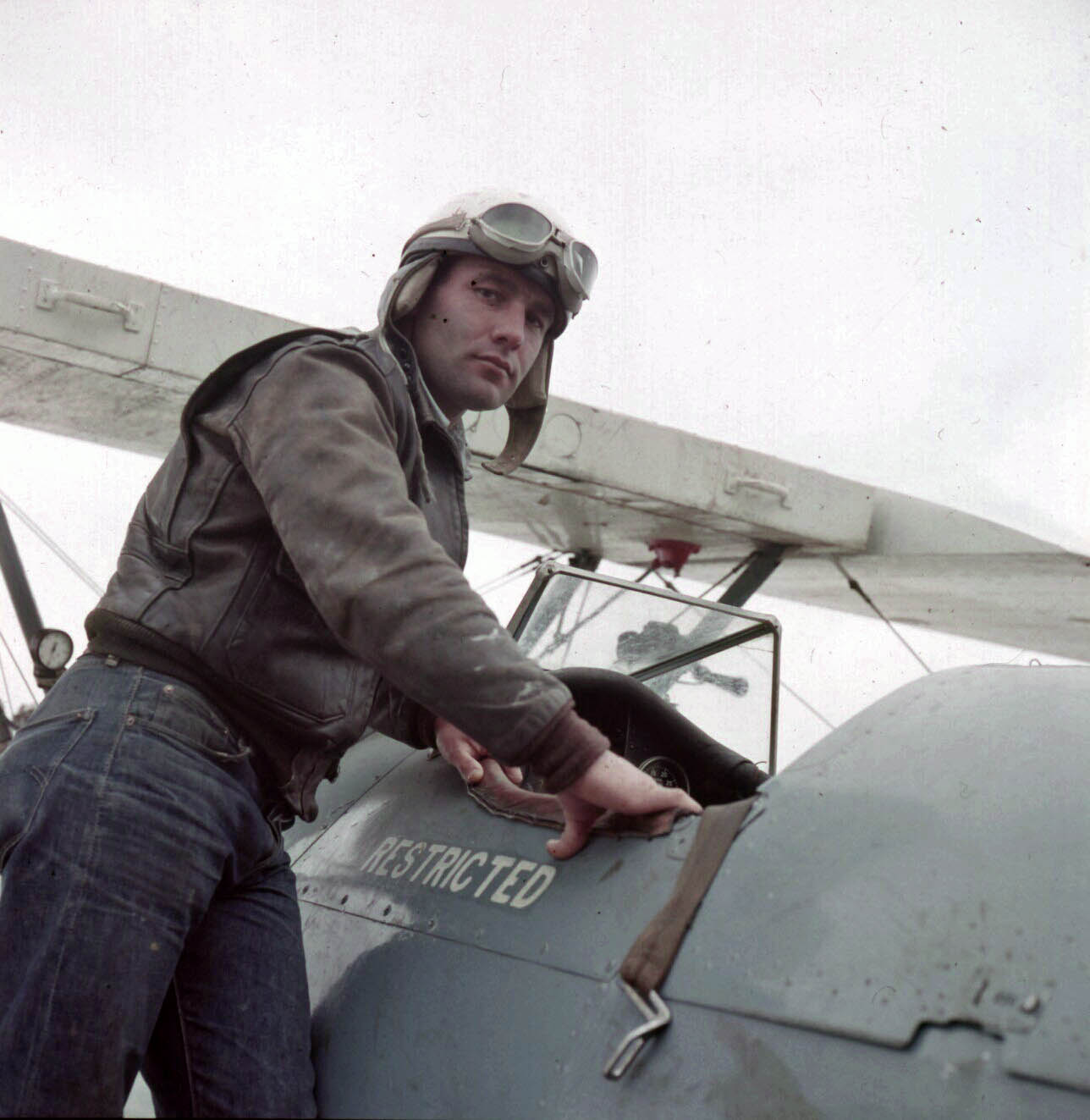



Other Details
CF-HGV Beaver
The Forest Protection Limited files had several images of a DHC-2 Beaver on floats, construction number 581: in black-and-white at the Fredericton Municipal Airport fly-in on May 24 and in colour at Charlo and Tabu airstrips. This aircraft was owned by Maritime Central Airways operating for the New Brunswick Forest Service.




Air Show at Charlo
At some point in the summer of 1957, Charlo airstrip hosted an air show for local people. The image shows the main runway (left to right, foreground), several Stearmans belonging to Farmer’s Crop Dusters and Vince Dusters, observation planes and the search and rescue helicopter at the rear. It’s delightful to see the old style autos and the women in long dresses. This area was remediated and turned into a local park and playground in 2003; for details see HERE.
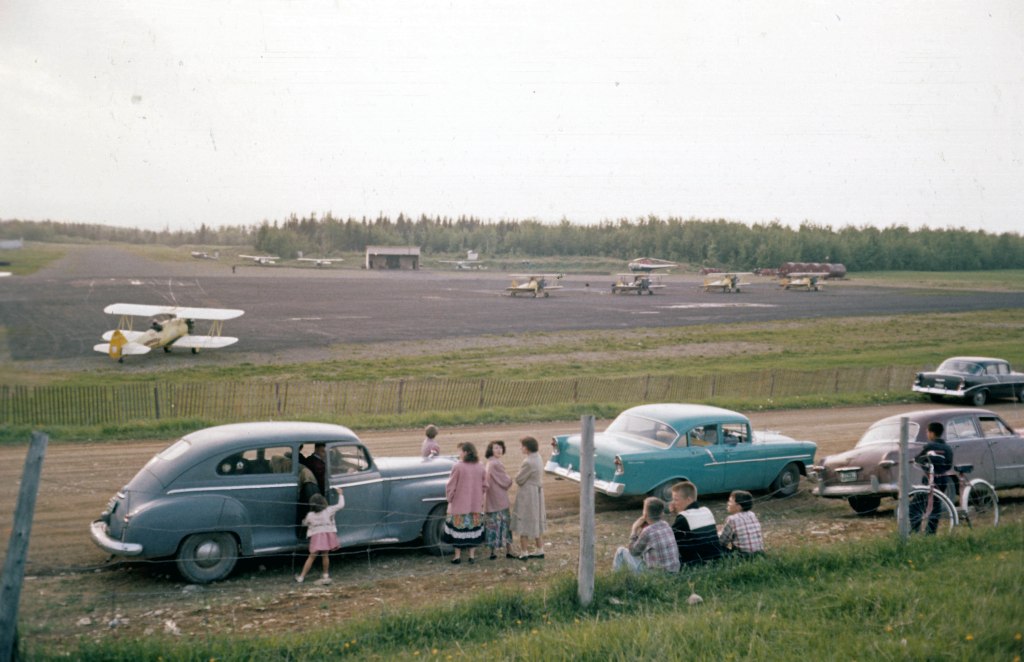
CBC Newsmagazine Film
The black-and-white CBC Newsmagazine film about spraying from Budworm City in 1957, called “Canada’s Forests: Budworm Infestation and DDT” (8:51) can be found in the CBC Digital Archives. The reporter was Kingsley Brown and the broadcast date was July 7, 1957. Screen grabs of CF-IAD and N5274N are included below. Mentioned in the film are:
- Chief Pilots Bob Yates and Charlie Alcock
- Earl Fitzgerald, Area Project Supervisor and unofficial “Mayor” of Budworm City
- Mike Gordy of Simcoe, Ontario, pilot of Wheeler CF-EQS
- Pat Korpatniki of Wetaskiwin, Alberta, pilot of Airspray CF-IAD
- View of Marsh #243 N5274N in air (not spraying) (pictured below)
- Views of parked Airspray Stearman #68 CF-IAD (pictured below)
- Views of 4 Wheeler Stearmans flying together


Dunphy Airstrip
“War council of budworm battlers” Pilots and personnel at at meeting at Dunphy airstrip, probably 17 June 1957. On the left is Farm-Air Stearman #105 N56803. [Telegraph-Journal, 18 June 1957; Forest Protection Limited files]


Search and Rescue Helicopter
The saga of the search and rescue helicopter to be in service for the spray period is an interesting one. A letter from Barney Flieger of Forest Protection Limited, based in Campbellton, N.B., and dated August 14, 1957, to Mr. K. Brown of the provincial Department of Lands and Forests, outlines the problems with obtaining a helicopter. Apparently, FPL’s request to obtain the services of a Royal Navy helicopter, as in past years, was declined. This resulted in a mad scouring of the continent by J.L. “Rusty” Mulcahy for one of the S-55 type, which turned up nothing. Mr. Mulcahy then tried for a less satisfactory (for search and rescue purposes) S-51. About May 24 he turned up one in Linden, New Jersey.
A Canadian company, World Wide Airways, stepped in and purchased the aircraft, thus allowing a speedy import to Canada. It was registered as CF-JNZ. The machine was already being modified for the spray operation conditions, and it started its ferry to Fredericton on May 26. The copter suffered some mechanical problems and returned to Linden, finally arriving in Fredericton on May 29. As a result of all these setbacks, the copter arrived two weeks late, at a time when 60% of the fleet had already passed through to project airfields. Barney says: “The machine paid for itself in bringing out a downed pilot but would not have helped much if our one fatality had been only a serious injury.” In that case, dense woods prevented the helicopter from lowering the doctor by cable.
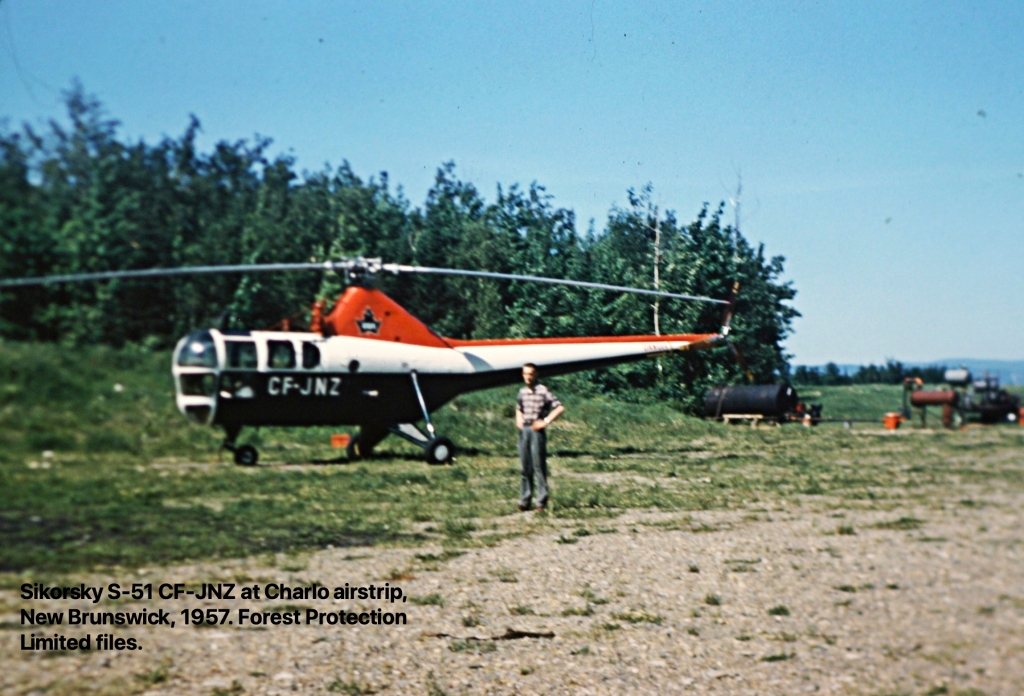
By the Skin of My Teeth: A Cropduster’s Story
By the Skin of My Teeth: A Cropduster’s Story by William “Bill” Robinet was the basis of much of the following. In this very readable book, Bill describes his years as a loader and a pilot cropdusting cotton with Stearmans and other ag aircraft in Arizona and Mexico for the years 1950 to 1957. He visited New Brunswick as a pilot to take part in the Spruce Budworm Spray Project for three of those years, 1955, 1956 and 1957, and his insights and descriptions of those situations are vivid and provide a real look at the program from the ground level up.
Billville Press is a book publishing imprint of WJR Enterprises, Inc., which is a company that buys and sells aircraft, repairs them and gives flight instruction; Bill Robinet is the president. He is a Mechanical Engineer, Flight Instructor, A & P mechanic and IA. He is also a recipient of the Orville and Wilbur Wright Master Pilot award. He has written two books and has a third nearly ready to publish. Leslie Robinet, Bill’s wife, is the company Secretary/Treasurer and a flight instructor. The stories below are told mostly in his own words. This was Bill Robinet’s last year on the budworm spray program.
Bill arrived at the Marsh facility to find out that John Neace was no longer manager; he was now a manger for Forest Protection Limited. The Marsh fleet of twenty left Arizona on the morning of May 15; their first stop was Liberal, Kansas. Gail Bishop was again the leader. The twenty planes eventually arrived at old Town, Maine, where the Chief Engineer of the Department of Transport examined the Stearmans.
Rosehill Airstrip
The next day the fleet arrived in Fredericton, New Brunswick, and then on to Nictau airstrip where they underwent calibration tests. The Nictau Chief Pilot then included them in a flight of eighteen that left for Rosehill, located just west of Bathurst, to await the commencement of spraying. After two years flying in pairs in New Brunswick, Robinet was assigned as the lead pilot. Lee Saucier was Chief Pilot.
Bill liked the flat terrain and the fact that the airstrip was close to “civilization.” “The locals were always hanging around the airport to watch the action. There was even a small automobile parking lot and a set of bleachers just off the runway ….” Rosehill, spelled Rose Hill in FPL literature, was historically called Rosehill Settlement, but the actual site of the strip was farther west in South Tetagouche, just north of Highway 180. Rosehill was an 18.2 ha property comprising an airstrip and surrounding properties, now woodland, one of three former airstrips owned by FPL. The site was prepared for reclamation in 1993. It was a typical U-shaped strip with landing to the north, the loading pits at the end, and takeoff to the south.
Eventually Bill and the crew moved on to Charlo airstrip, the headquarters of the project, but their stay there was short. They moved on to Quebec and Cap Chat for the remainder of the season.
Eight of the Stearmans, including Robinet’s, were to fly to Charlo, spend the night, then move on to Fredericton with eight others who had departed from Grog airstrip. Bill takes ten pages to describe what happened next (see below).
Gallery: Bill Robinet and his Marsh Stearman N53429 #271 at Taxes, New Brunswick, 1957. Bill reports that this was taken at Taxes in 1956, but the number, registration and owner logo are that of the aircraft he flew in 1957. [By the Skin of my Teeth: A Cropduster’s Story]

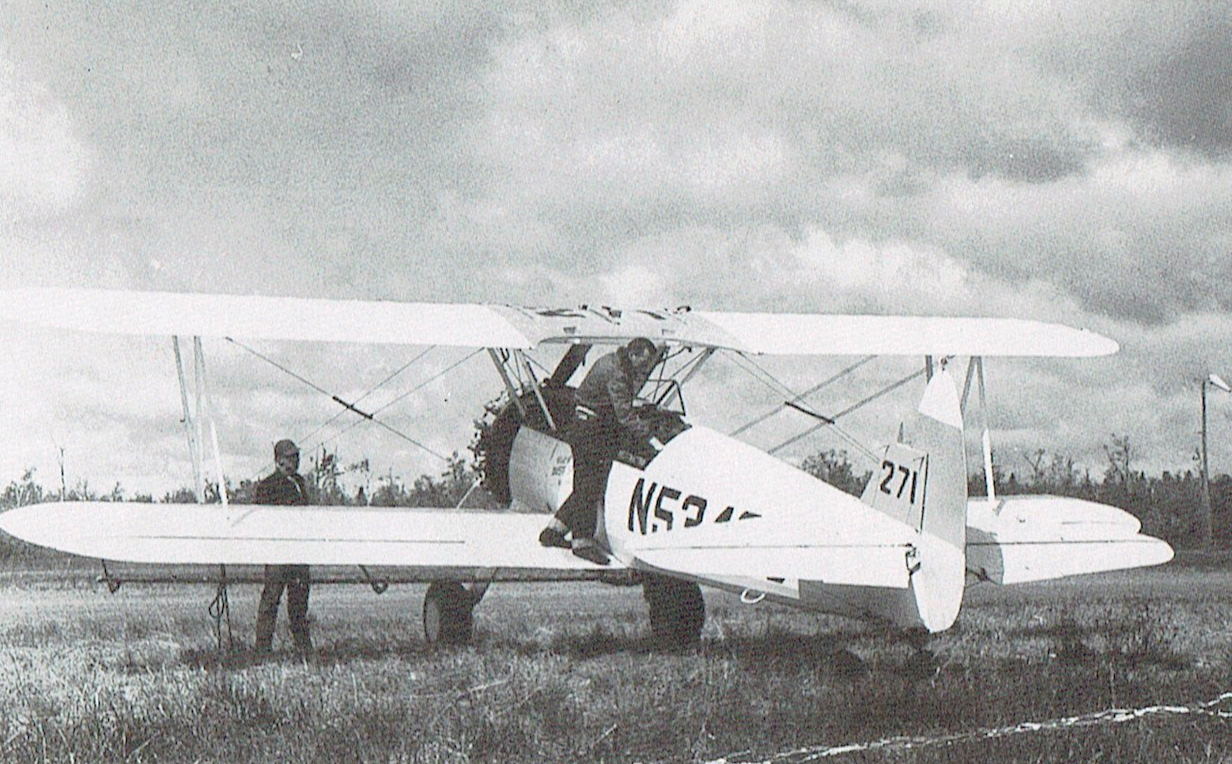

Accidents
Mosquito spraying, May 30
Wheeler Stearman CF-EQY, piloted by Rodney Wray, collided with high tension wires 300 ft south of the Humphrey railroad Station near Moncton, N.B., on May 30, 1957. This was one of two Wheeler Stearmans that had been applying DDT to the marshes in the Moncton area. The damage was substantial and pilot Wray was not injured.
The DOT card below provides more details.


The First Fatality, June 20
On June 20, the first fatality of the six-year budworm project occurred. Pilot Elwyn G. Behnke, from Eagle Point, Oregon, and of Medford Air Services, crashed into thick forest three miles south-southwest of Budworm City. He was piloting Medford #90 N1054N. Behnke had departed Budworm City at 6:09 a.m. About 11 minutes later, the pilot of his companion aircraft saw the crash from an elevation of about 300 feet. The S-51 helicopter was dispatched from the Charlo airstrip, but the dense woods prevented the pilot from lowering Dr. Graham Little to the site. The copter landed a mile away, and Dr. Little hiked in, reporting later that the pilot had been killed. A ground party arrived from Budworm City, and the pilot’s body was removed and transported by the helicopter to Budworm City, then to Charlo and later to an undertaker in Campbellton. The DOT accident card records that the aircraft failed to maintain adequate flying speed and spun off in a left-hand turn at low altitude; the aircraft was destroyed. Behnke leaves a wife and five children.
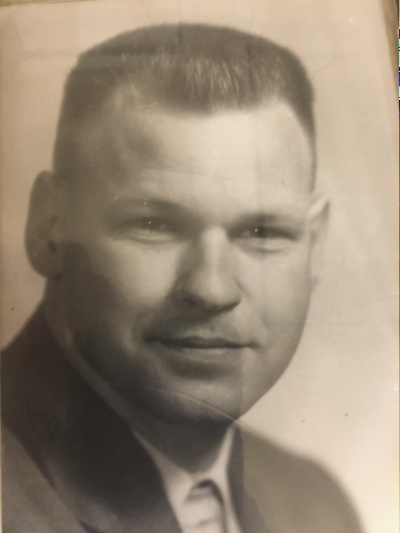


More accidents in June
Marsh Aviation #244 N5192N T piloted by James F. Gaylor suffered a loss of power and crashed June 9 at Taxes airstrip; there was substantial damage but no injuries. The DOT card states that N5192N was operated by the American Dusting Company.


Quaadman Dusters #32 N68456 piloted by Ernesto Ballester suffered substantial damage while attempting a landing June 25 at Nictau airstrip (DOT card). The pilot was not injured.


Ueding Flying Service #27 N1535N piloted by V. Bullard underwent a forced landing June 25 1.5 miles northeast of MacFarlane airstrip; there was substantial damage but no injuries (DOT card).


Accidents on July 1
Farmers’ Crop Dusters #316 N53040 piloted by J. Welton forced landed July 1 4 mi northeast of Nepisiguit Lake; damage was substantial but the pilot was not injured (DOT card). The cost of ferrying this aircraft to California dragged on until early 1959!
According to a letter from Art Seller of Skyway Air Services to Barney Flieger of FPL (February 4, 1959), Skyway “paid Joe Hammer to pick up the wrecked machine and take it to California at a cost to us of $600 plus the additional cost of sending a truck and a man down to Sacramento to bring it back to Langley.” Skyway thought that they should have been paid “return trip ferry time for the aircraft.” Seller also complained that letters to Wheeler Airlines had gone unanswered, and that payment for the project had not yet been received.
Flieger wrote back on February 9 that he believed that Sellers would not get any payment for the wrecked machine from Wheeler, the reason being that Wheeler could not recover it from the spraying authorities. Flieger stated that FPL cannot become financially involved with crashed aircraft as such aircraft are covered by insurance. By prior agreement FPL had decided to pay ferry costs only on aircraft that flew back home.


Leavans Bros. #75 CF-FRY piloted by John Lingham nosed over at Budworm City on July 1 after overflying the runway; damage was substantial, but pilot Lingham was not injured (DOT card).


Spray Planes are Forced Down – July 5
Bill Robinet’s account: We arrived at Charlo in the afternoon (of July 4), but things seemed to be moving slowly in the morning. Of the sixteen Stearmans that had gathered at Charlo for the trip out, only four were from the original group of twenty that had come from Arizona in May. The take-off the next morning was being delayed because the airstrip officials were waiting for the weather report. However, at 7 a.m., the group was given the OK and headed for Fredericton in pairs with Cessnas in the lead and at the end. About twenty miles from Fredericton, Bill noticed a large bank of clouds, which soon became a solid undercast, and found out later that they had overshot the city. Eventually, the Chief pilot made a 180 degree turn and tried to take the group to the Taxes airstrip.
Bill observed one Stearman go down from lack of fuel, and found out later that two others did the same. He worried about his chances of making it to Taxes given that he also was running short of fuel. They were over the small community of Durham Bridge when he saw his flying partner head for an opening in the cloud deck. Should he follow or stay with the group, only to run out of fuel on the way to Taxes? He followed his team mate down through the hole in the clouds and they suddenly saw an L-shaped pasture that looked appealing for an emergency landing. His partner went for it, but there was no way both planes could land there together at the same time because of the chances of collision. Bill flew over the field and saw that his partner had landed safely, so he landed at the far end of the field and taxied along to where his partner was. By this time the fuel gauge was reading empty. Bill looked at his watch and saw that it read 9 a.m., just two hours after they had left Charlo. There was no damage to either of the Stearmans.
A man, Arnold Frazer, who had been driving home to Nashwaak Bridge, had seen the planes land and drove up to offer help. Frazer took them to a local store where they used the phone to inform an official at the Fredericton Airport of their situation. Then they obtained some fuel at a local bulk station (Bill says that he convinced the attendant to bill it to Wheeler Airlines) and returned to fuel up their planes.
Eventually they took off, Bill leading as usual and his buddy following closely, and headed to Fredericton Airport by following the local roads. However, perhaps feeling a little too cocky, Bill missed the turn-off to the airport. After a period of searching, he found the runway and both planes landed safely. At about 3 p.m. at the airport Bill gave a fifteen-minute interview with a reporter of local radio station CFNB in which he recounted all the events of the last few days.
They were shuttled to a Fredericton hotel where “everybody” was staying, including Forest Protection Limited officials from Montreal who were there to confer with federal Department of Transport officials in the investigation of the days “fiasco.”
Bill was cleared to return to Arizona the next day, but he had significant engine trouble on the way. Because of massive oil loss, Bill had to ditch N53429 in a field near Sullivan, Missouri, where he had to abandon it.
Other accounts: After operations had ended, 5 planes from a squadron of 11 were forced down near Penniac (just north of Fredericton) “on July 5 … as they were returning to the U.S. from the northern part of the province. All the pilots escaped serious injury as heavy fog and lack of fuel were the main cause of the accident.” [W. Seto, unpublished report to FPL] Two of the craft were extensively damaged.
The Moncton Daily Times reports (June 6) what happened. The squadron was headed to the Fredericton Municipal Airport to refuel, but pilot Bill Lininger of Yakima, Washington, said that the field was fogged in. He said that they were over Penniac when a plane piloted by Dick Joyce of Phoenix, Arizona, was forced down in a field, broke through a fence and nosed over, losing a wingtip. Lininger and Joe Curry circled over the field until Joyce signaled he was OK. They ran out of fuel near Charters Settlement (called Chartersville in the article, but that is actually in Moncton/Dieppe and not likely to be the crash site) and selected an intersection on Route 28 (now called Route 101) where Curry made a forced landing. The left wing of the plane struck a telephone pole, causing it to nosedive, but Curry escaped with only bruised ribs. Lininger landed in a nearby field.
Two other planes were forced down along the St. John River, but the rest of the squadron returned to the Taxes airstrip.
The Daily Gleaner article and images. The following article and images was published in Fredericton’s The Daily Gleaner on Friday, July 5, 1957. Featured are Joe Curry and Bill Lininger. Bill’s aircraft, Marsh #279 N4812V, landed safely and was not damaged (no DOT card). Dick Joyce’s aircraft, Marsh #284 N4740N, was substantially damaged but he escaped with no injuries (DOT card). Joe Curry piloted March #223 N64758 and also escaped with no injuries but with substantial damage to the aircraft (DOT card).


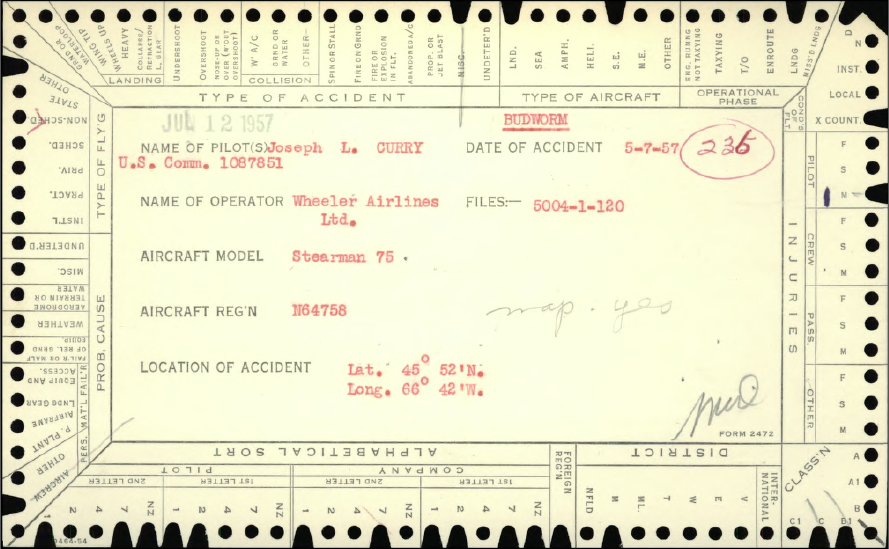




QUEBEC
DDT was applied to 1,255,000 acres in 1957. “In the peak year of operations (1957) 80 spray aircraft and 12 inspection aircraft operated from 9 airstrips constructed for this purpose.” [Blais et al. in Prebble 1975] Webb et al. (1961) state in Table 2 that 107 Stearman sprayed in Quebec. Airstrips used were Patapedia, Cap Chat, Laverendrye, Nouvelle, Lesseps and Pabos; the latter two airstrips were constructed for the 1957 project. Farm Lake was not used this year. Spraying started on June 13, five days earlier than 1956, and ended on July 5, four days later than in 1956 because of unfavourable weather. Commercial airfields Rimouski and Gaspé were also used.
Accidents in Quebec
Hicks and Lawrence #60 CF-JOU (typo, JOV in list) piloted by George Franklin Pressey made a forced landing May 29 near Courcelles, Quebec, after he realized he was low on fuel (DOT card). Damage was substantial but the pilot was not injured. Courcelles is east of Montreal, and CF-JOU would have left the Cartierville Airport, located on Montreal’s south shore, that morning on its way to New Brunswick.
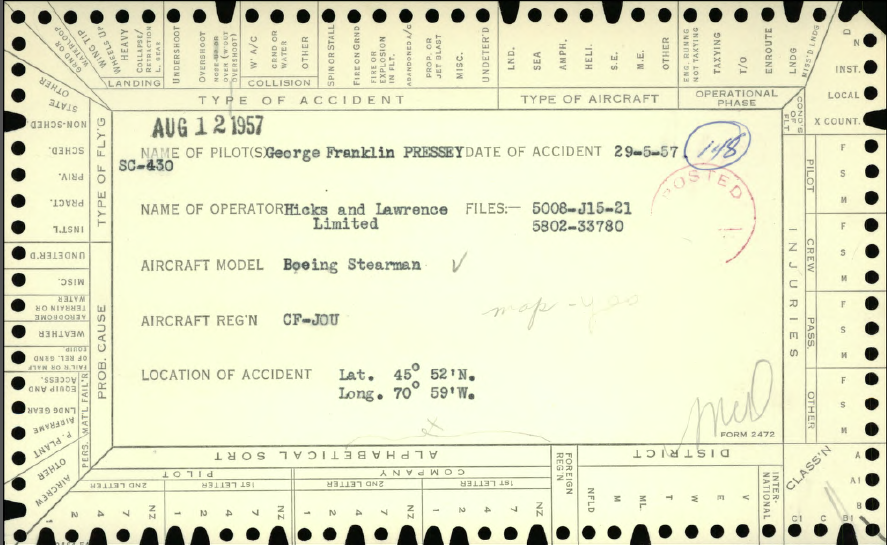

Skyway Air Services #70 CH-HKZ piloted by J. Blackham and Bradley Air Servives #84 CF-JLS piloted by O. Osen collided at Cartierville, Quebec, on a stopover on the ferry to N.B., May 30. HKZ ran into a parked JLS after the pilot had started the engine; damage to both aircraft was minor. This is described in the DOT card below, which also stated in pencil that it was “not an accident”.


Farm-Air #110 N53236 crashed at Pabos airstrip June 30, flown by pilot Robert Annon. It was destroyed by fire, but Annon was not injured. The DOT card (below) states that the aircraft was operated by Miller Dusting Company, which was probably a contractor under Farm-Air.


Cap Chat Airstrip
Bill Robinet describes being at the Cap Chat airstrip in 1956 (see 1955 HERE for two images), located on the north coast of the Gaspé about 60 miles inland from Matane and the nearby coastal community of Cap Chat [English: Cape Cat]. This Gaspé airfield was configured such that the departure was the same direction as the landing, with the pits situated in a dogleg in the middle. The landing approach was from the east, then a right turn into the pits and a left turn to leave them for the takeoff runway. Bill Robinet and colleagues spent the remainder of the 1957 season at Cap Chat. Compared with Rosehill, the flying in the Gaspé was difficult, as most of the flying required a flight over a mountain range.
Robinet describes a chaotic arrival at the tricky airstrip in which many of the aircraft had to do a go-around, resulting in several mishaps. In his words, “four airplanes were creamed on that very first landing at Cap Chat, including one that landed on its back.” However, I have not found DOT accident cards for any of these.
